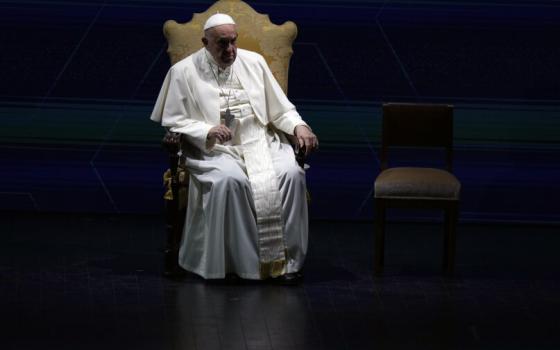Any assessment of Pope Francis at the two-year mark of his papacy would do best to first deal with the unrealistic expectations and the disappointments that often drive the discussion over whether he is a true reformer.
On one hand, Francis is not going to ordain women or marry a gay couple during his tenure as pope. His attitude toward women seems woefully outdated, calling them "strawberries on the cake." Despite his words about including women in the church, he has yet to involve them in any substantial way in church governance.
On the other hand, he will not suddenly become princely and engage in the royal court culture that flourished during the era of Popes John Paul II and Benedict XVI and in which blossomed the crimes and corruption that Francis inherited.
Nor will he suddenly reverse course and reinstitute a tick list of orthodoxies as the measure of Catholic identity, or worry inordinately about what prevailing hermeneutic will result in the purest expression of the church.
If he is, then, dispensing disappointment across the spectrum, what accounts for the fascination with him that seems unabated since he appeared on the balcony the evening of his election in simple garb, gave a simple greeting, and asked the crowd to silently pray for him?
There is a point where the line between substance and symbol begins to blur, especially in the Catholic imagination, so richly wired to receive and understand symbol in service of truth. A Pew Research survey finds Francis rates a 90 percent "very" or "mostly favorable" rating among U.S. Roman Catholics -- 95 percent for Catholics who attend Mass regularly. Pope John Paul II topped the popularity charts at 93 percent during his visit to the U.S. in 1996.
Francis' symbols are different from those of the two previous papacies. Under those inextricably linked reigns, the priorities, evidenced in pronouncements and episcopal appointments, were to patrol the boundaries, severely limit the scope of permissible questions, and emphasize the distinctions between the ordained and everyone else.
Author Austen Ivereigh, who dared to title his masterful biography of Francis The Great Reformer, has delivered a persuasive analysis of what we're witnessing: "Just as the church in Spain and Italy was the source for the Counter-Reformation, and the church of France and Germany the source for the Second Vatican Council, Latin America is now the wellspring of a new era of church reform."
Francis perplexes Europeans and North Americans who have split the analysis along a liberal-conservative axis, writes Ivereigh, "because he uses a lens and a language that come from outside those categories."
Francis wades into slums, embraces those who otherwise might inspire revulsion, refuses to draw boundaries so rigidly as to exclude anyone, welcomes all questions and robust debate, and leads with the God of mercy.
He preaches "the art of encounter," which requires moving beyond the safety of the church building and walking with the people. It is an approach schooled in the slums of Buenos Aires, Argentina, where the norm is broken lives, messy, stressed and needy.
It is in those circumstances, he preaches, in the irrational embrace of the prodigal, that grace abounds. In a recent visit to a parish in Rome, he instructed its leaders to avoid telling people where they were wrong, but to "get closer" to the people, walking with them and respecting their needs.
He has relentlessly preached on themes of economic injustice, and he will soon release a pastoral on the environment and care for creation, the mere suggestion of which has sparked organized resistance. He may be beloved at street level, but he is making powerful enemies in other quarters.
Francis was also selected by his peers to accomplish reforms closer to home, particularly of a Curia and a clerical culture that had become so distorted that leaders brazenly betrayed the community and the Gospel in crises ranging from the horrors of sexual abuse of children to more prosaic financial scandals.
It is here that the greatest anger and resistance are building. This is family, after all, and he's coming in as the outsider, inheriting the CEO's spot, and declaring that the family business, run in a certain way for centuries, will now dramatically change.
The cruel reality is that the church has no mechanism for change. For centuries, it believed it couldn't change, even as it was changing.
In two years, Francis has gone a great distance in bringing about financial reform by putting in place meaningful checks and balances. Reform of the Curia, however, remains at a homiletic level. The question is whether he can effect meaningful reform by continuing to choose leaders from the very clerical culture that caused the problems in the first place.
The new commission of cardinals devoted to reform and the commission he initiated to deal with sex abuse are hopeful new developments. On the latter issue, however, he has failed to act as a pope can, allowing bishops who have bankrupted dioceses and breached church and civil law to remain in place. It is difficult to believe Francis' claims about accountability when a bishop in the United States, criminally convicted of not reporting an abusive priest, remains in charge of a diocese, or when a bishop in Chile, enmeshed in a cover-up scandal, receives a promotion.
The battle may be even more significant on the matter of changing the broader ecclesial culture, where those who once established their bona fides by declaring absolute obedience to pope and magisterium have suddenly discovered a certain elasticity in their pledges.
They, ironically, enjoy the luxury of a papal attitude they previously would have disdained -- a tolerance for disagreement and debate that would have had them reaching for the excommunication papers in an earlier era.
The depth of reform during the Francis years will depend on time and how successful he is in shaping an episcopacy in agreement with his vision. The longest-lasting reform may be the education that Catholics and the rest of the world are receiving: that the church can and does change and that what may be perceived as chaos in one papacy is, in another, an opportunity for encounter.


